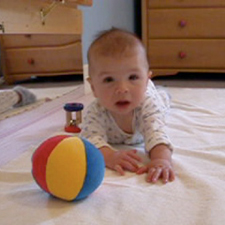Motor skills the ability to move some part of the body, in actions ranging from the large leap to a flicker of the eyelid.(The word motor here refers to the movement of the muscles.) Strictly speaking, the infant's first motor skills are not really skills but reflex's. Reflex's is an involuntary response to a particular stimulus. It is also a automatic response that is naturally built into the infants nervous system and it occurs without conscious thought. There are 18 kinds of reflex's but there are three sets that are critical for survival. Reflexes that maintain the oxygen supply, reflexes that maintain constant body temperature, and reflexes that facilitate feeding.
 Gross motor skills is deliberate actions that are coordinating many parts of the body, producing large movements. Between the months eight and ten after the birth most infants can lift their midsections and crawl. If you ever heard that babies must crawl to develop normally is not true. All babies find out some way to move before they can walk. Examples are: inching, bear walking, scooting, creeping, or crawling. Most babies resist whats called "tummy time" by rolling over and fussing to indicate to parents that they do not want crawling practice. (Adolph & Berger 2005)
Gross motor skills is deliberate actions that are coordinating many parts of the body, producing large movements. Between the months eight and ten after the birth most infants can lift their midsections and crawl. If you ever heard that babies must crawl to develop normally is not true. All babies find out some way to move before they can walk. Examples are: inching, bear walking, scooting, creeping, or crawling. Most babies resist whats called "tummy time" by rolling over and fussing to indicate to parents that they do not want crawling practice. (Adolph & Berger 2005)
Fine motor skills are what you call small body movements, especially of the hands and fingers. Examples of that would be drawing, and picking up coins. Newborns have a strong reflexive grasp but seem to lack hand and finger control. By four months, infants sometime grab, but their timing is off: they close there hands to early or too late. Pull, grab, look, and listen. Using every sense at once is a baby's favorite way to experience life, generating Brian connections as well as commotion.
 Childhood has many problems when growing up. Their are a lot of deadly virus that are around us. Immunization is a process that stimulates the body's immune system to defend against attacks by particular contagious disease. Examples of those would be the Measles, whopping cough, pneumonia, and other illnesses that could be a childhood killer. The immunization can either be injected or by naturally. Smallpox, the most lethal disease for children in the past, that was worldwide of 1971. Polio a crippling and sometimes fatal disease, has become very rare. Measles is disappearing worldwide, thanks to vaccine developed in 1963. A problem with immunization that parents do not always make sure their children get vaccinated on the recommended schedule. Sudden infant death syndrome is a situation in which a seemingly healthy infant, at least two months of age, suddenly stops breathing and dies unexpectedly while asleep.
Childhood has many problems when growing up. Their are a lot of deadly virus that are around us. Immunization is a process that stimulates the body's immune system to defend against attacks by particular contagious disease. Examples of those would be the Measles, whopping cough, pneumonia, and other illnesses that could be a childhood killer. The immunization can either be injected or by naturally. Smallpox, the most lethal disease for children in the past, that was worldwide of 1971. Polio a crippling and sometimes fatal disease, has become very rare. Measles is disappearing worldwide, thanks to vaccine developed in 1963. A problem with immunization that parents do not always make sure their children get vaccinated on the recommended schedule. Sudden infant death syndrome is a situation in which a seemingly healthy infant, at least two months of age, suddenly stops breathing and dies unexpectedly while asleep.
Nutrition is best for newborns. Breast is best for most newborns it gives good nutrition. Colostrum, is a thick high-calorie fluid, is secreted by a womens breast for about the first three days following the birth of the child. The specific fats and surgars in breast milk make it more digestible, and probably better for the infant brain, than any prepared formula (Riordan, 2005). Breast milk apperas to have so many advanatges over formula that some critcs question the validity of the research: Perhapes women who choose to breast-feed are better caregivers which might explain the superior situation of breast-fed babies. Other researches say that bottle-feeding may sometimes be better, such as when the mother is HIV-positive or use toxic or addicitve drugs. Many doctors worldwide recommended exclusive breast-feeding for the first four to six months.
Protein-calorie malnutrition is a condition in which a oerson does not consume sufficeint food of any kind. This deprivation can result in several illnesses, severe weight loss, and even death. The worst disease directly caused by malnutrtion is marasmus. Maramus is a diease of serve protein-calorie malnutrition during the early infanacy, in which growth stops, the body tissue waste away, and the infant eventually dies. Another diease is Kwashiorkor in which during childhood, which a protien deficienty makes the child more vaulnerable to other diesease, such as measles, diarrhea, and influneza. The child growth is retarded; the liver is damaged; the immune syster is weakened, the face, legs, and abdomen swell with fluid.
Melissa Becerra

No comments:
Post a Comment